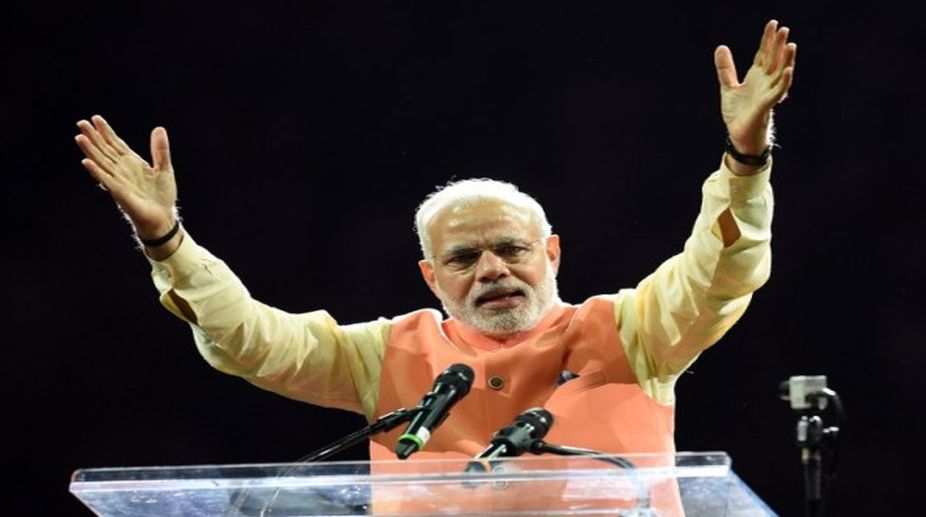Lok Sabha Election 2024, Phase 1: Voting on 102 seats underway
In the first phase of Lok Sabha elections 2024, as many as 102 constituencies spanning across 21 states and Union Territories will elect their new MPs.

Prime Minister Narendra Modi at Madison Square Garden (PHOTO: TWITTER)
After gaining a landmark victory in the recent 2017 legislative assembly elections, Prime Minister Narendra Modi, delivered a speech at the headquarters of his party. He emphasised once again developing a ‘new India’. If we go in accordance with the current level of pollution, global warming and greenhouse effect, the question that arises is whether future generations will ever be able to see that ‘new India’ or will it simply be taken as political rhetoric?
During his first speech at Madison Square Garden in September, 2014, Mr. Modi similarly talked about developing a ‘new India’ by providing incentives to the start-ups and strengthening the information technology sector. Aware of climate change, the Union Government also recognized the importance of a clean environment and passed ambitious projects like rejuvenating the Ganges and ‘Swach Bharat Abhiyan,’ which led to raising taxes to fulfill that project.
Before delving into clean energy technology and the barriers faced by it from intellectual property law, it may be helpful to define the term clean energy. Clean energy means energy created from renewable sources of energy with low impact on the environment. The possible examples might include wind energy, solar energy and hydropower. The budget of 2010-11 created the National Clean Energy Fund (NCEF) for funding research and innovative projects for clean energy technology.
Advertisement
Recently, Finance Minister Arun Jaitley renamed the Clean Energy Cess as Clean Environment Cess and doubled its magnitude. The coal cess yielded a mammoth Rs 54,336 crore, but only Rs 12,427 crore will be spent on renewable energy projects. The recent 2017-18 budget raised many eyebrows vis-a-vis the Government’s spending on clean energy technology. The 2017-18 budget allocation to the Ministry of New and Renewable Energy of Rs 5,473 crore has barely increased from the allotment in 2016-17. Although it gave positive signals on developing biomass and methane-based clean energy through raising indirect tax incentives on them, it also raised concerns for declining financial support for research and further development of clean energy.
The budget proposed a second phase of solar park development for an additional 20 GW, which would bring the installation target for solar parks to 40 GW. (Note that 40 GW of solar energy is greatly reduced by darkness, clouds, rain and transmission losses.) In September 2015 even the Reserve Bank of India introduced masala bonds that helped finance clean energy technologies.
The temperature around the world is generally increasing. With more effects of global warming and the greenhouse effect, emission of carbon gases like carbon dioxide and methane will increase in coming years. Clean energy is the quickest and cheapest response to these increases.
Article 4.5 of the United Nations Framework Convention on Climate Change indicates that developed countries should assist developing countries in getting or obtaining cleaner sources of energy. Article 4.7 of the UNFCCC has laid out the Clean Development Mechanism indicating how assistance can be provided to a developing country by a developed one.
The Supreme Court in the case of G. Sundarrajan vs Union Of India & Ors observed that for the protection of environment, clean energy technology or renewable sources of energy should be preferred over non-renewable sources of energy.
For adequate use of clean energy, the concept of net metering can play a crucial role. Net metering is mainly used in the case of solar and wind energy. It is used to store electricity generated from these clean sources. Consumers can use this energy whenever they want to use it, which minimises the wastage of energy produced. The energy is aligned with the main grid through net metering. Net metering has gained prominence in Germany and Japan. When energy use is low, net metering allows people to pay less than the wholesale price of the electricity.
Some scholars have had concerns about the barriers that clean energy will face from intellectual property laws. The laws pertaining to intellectual property play a different role in the case of clean energy technology as compared to the pharmaceutical sector. In the pharmaceutical sector, if a drug company obtains a patent over a drug then it gains a monopoly over it and no other pharmaceutical company is generally allowed to manufacture that drug. That patent holder even gets the right to decide the prices of its product by virtue of the monopoly it obtained through a patent.
In the case of clean energy technology, if one obtains a patent, the patent holder gets a patent only for the modifications in the energy source done by that holder. This creates a competition for different players in the field of clean energy technologies. Consumers are benefited by a better clean energy product which, because of competition, may lead to a reduction in the prices. Thus, the intellectual property laws can benefit the consumer and also, importantly, the planet as a whole.
Clean energy technologies, like solar and wind, are abundant and cheap. Considering the many adverse impacts of climate change, it is essential for the Government to pass laws that promote the extensive use of clean energy technologies.
The writers are, respectively, professor of law and a law student at Jindal Global University, Sonipat.
Advertisement